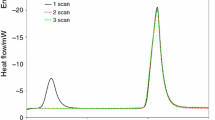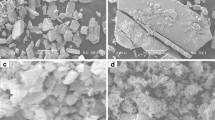Abstract
Hexanitrostilbene (HNS), is added to trinitrotoluene (TNT), in order to improve the grain structure of cast munitions. The formation and composition of the nucleant material has been investigated by thermal methods using mixtures of HNS and TNT, with composition in the range 0.5%, the normal casting level, to 50% w/w HNS to TNT. These were cycled between ambient and upper temperatures in the range 160 to 235°C. Endotherms in the DSC traces, due to nucleant decomposition, have been observed in situ without the need for separation and purification. DSC enthalpy measurements, before and after thermal decomposition, were used to determine the composition of separated nucleant. Nucleant regeneration after decomposition, was investigated by thermal methods. Nucleant could not be recrystallised from solvents. Results have been interpreted on the basis of the formation of a, solid solution of TNT in HNS, rather than a complex of formula TNT2HNS.
Zusammenfassung
Zur Verbesserung des Gefüges wurde zu Trinitrotoluol (TNT) Hexanitrostilben (HNS) zugemischt. Unter Verwendung von Gemischen aus HNS und TNT im Bereich von 0.5- 50 Gew.% (HNS/TNT) wurde die Bildung und Zusammensetzung des keimbildenden Materiales mittels thermischen Methoden untersucht. Dies erfolgte cyclisch zwischen Raumtemperatur und einer oberen Temperatur im Intervall zwischen 160 und 235°C. Ohne erforderliche Trennung und Reinigung konnten in situ, infolge der Zersetzung des Keimbildners Endothermen im DSC-Verlauf beobachtet werden. DSC Enthalpiemessungen vor und nach der thermischen Zersetzung wurden zur Bestimmung der Zusammen-setzung des separierten Keimbildners verwendet. Die Keimbildnerregenerierung nach der Zersetzung wurde mittels thermischer Methoden untersucht. Der Keimbildner konnte aus Lösungsmitteln nicht umkristallisiert werden. Die Ergebnisse wurden auf der Grundlage der Bildung einer festen Lösung von TNT in HNS und nicht eines Komplexes der Formel TNT2HNS interpretiert.
Similar content being viewed by others
References
R. Meyer, ‘Explosives’, Third Edition, V. C. H. Publishers, Weinheim, F. R. G., 1988, p. 367.
M. J. Margolin and E. A. Skettinni, ‘Ammunition Loading Techniques’ Explosives Development Section Report 43, 1958, Picatinny Arsenal.
A. R. V. Steele et al., British Patent 765210 (1957). See Also F. Meissner, G. Waunnschaff and G. F. Othmer, Ind. Eng. Chem., 46 (1934) 718.
W. S. Wilson, J. Crystal Growth, 71 (1985) 23.
W. R. Carper, L. P. Davis and M. W. Extine, J. Phys. Chem., 86 (1982) 459.
F. Gerrard and A. Hardy, Acta. Cryst., C44 (1988) 1283.
L. A. Burkardt, Anal. Chem., 26 (1954) 1255.
J. G. B. J. Bergeron, M. Sc. Project Report, Cranfield Institute, 1989, p. 48.
W. R. Eubank and R. W. Van Dolah, Report of the Naval Ordnance Test Station NOTS 316, 1950.
D. K. Philp and B. W. Thorpe, J. Crystal Growth, 35 (1976) 133.
M. A. Parry and B. W. Thorpe, ‘Nucleation and Growth of TNT containing HNS’, Report MRL-R-708 1978, Material Research Laboratory, Melbourne.
M. A. Parry and B. W. Thorpe, J. Crystal Growth, 47 (1979) 541.
M. A. Parry and B. W. Thorpe, ‘The Effective Nucleant During the Grain Modification of TNT Containing HNS’, Report MRL-R-748, 1979.
M. A. Parry and B. W. Thorpe, ‘Influence of HNS on the Microstructure and Properties of Cast TNT’, Report MRL-R-812. 1981.
P. Pelletier, F. Beaupre and J. G. Melancon, ‘Effect of, Additives on the Mechanical and Thermophysical Properties of TNT’, Report CRDV R-4526/89, 1989.
L. Yng-Long et al., Propellants, Explosives, Pyrothech., 15 (1990) 22.
S. Back, J. L. Soderberg and E. L. Hakanson, English Patent 1,249,038, granted to Bofors Explosives A. 1971.
W. A. Gey, Daiby and R. W. Van Dolah, J. A. C. S., 78 (1956) 1803.
K. G. Shipp, J. Org. Chem., 31 (1966) 857.
M. Cartwright and G. C. Collett, J. Energetic Materials, 11 (1993) 167.
H. G. McAdie, Canadian J. Chem., 44 (1966) 1373.
S. Glasstone, ‘Textbook on Physical Chemistry’, Macmillan and Co. Ltd., London 1956, p. 865.
R. Forster, ‘Organic Charge Transfer Complexes’, Academic Press, London 1969.
Encyclopaedia of Explosives and Related Items, Vol. 9 U.S. Army Research and Development command, Weapons Systems Research Laboratory, Dover, New Jersey, U.S.A.
L. A. Burkardt, J. Phys. Chem., 66 (1962) 1196.
Author information
Authors and Affiliations
Rights and permissions
About this article
Cite this article
Cartwright, M., Hill, C.J. Thermal investigation of the crystallisation nucleant formed between 2,4,6 trinitrotoluene, (TNT) and 2,2′,4,4′,6,6′ hexanitrostilbene (HNS). Journal of Thermal Analysis 44, 1021–1036 (1995). https://doi.org/10.1007/BF02547530
Received:
Issue Date:
DOI: https://doi.org/10.1007/BF02547530




